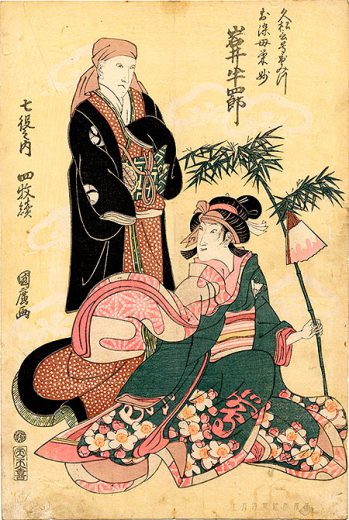Actors’ Makeup in Ukiyo-e paintings
March 7 (Tue), 2017 – June 4 (Sun), 2017
This museum exhibits ukiyo-e paintings produced in Osaka in the Edo period. Many of the ukiyo-e paintings made in Osaka were portraits of actors in a kabuki play. You can see the scenes of kabuki plays performed in theatres in Dotombori area in these paintings.
There are several rules of kabuki (i.e. actors are all male) by which unique worldview is expressed. Kumadori, among others, is stage makeup unique to kabuki and its color and design is different according to the role.
In this feature exhibition we focus on makeup of kabuki actors in ukiyo-e paintings. Here we introduce not only brave-red kumadori, but also female (both young women’s and wives’) makeup in ukiyo-e paintings. In the exhibited paintings, please see their desire to be beautiful which is as same as ours today.

Osome-Hisamatsu-Ukinano-yomiuri
Drawn by Kunihiro
Portrait of Hisamatsu Gengo Omitsu and Osome’s mother Eimyo, performed by Iwai Hanshiro V
Kumadori
Kabuki plays are roughly divided into two categories: jidaimono (which covers historical episode) and sewamono (which covers the lives of townsmen of the time). While in sewamono, actors’ costumes are based on those of the time, in jidaimono, kumadori is used in order to exaggerate the event or the character.
Red kumadori is used mainly for the heroic character with strong sense of justice. Although red is also used for namazuguma (catfish shaped kumadori) or akattsura (red face) – they are all enemy roles– but the difference is obvious. Aiguma, blue kumadori, is for the archvillain like Fujiwara no Tokihira in Sugawara Denju Tenarai Kagami. Brown kumadori is used to for demonic creatures like oni and yokai.
Kumadori emphasizes the muscles and blood vessels on a face and the color is fixed according to the role, so the audience were able to see who was playing which role even in darker-than-present theatres.
Red makeup “sasairo-beni”
While kumadori makeup is only for characters in kabuki plays, makeup for actors who play female role is close to those of women’s at the time. Ukiyo-e paintings at the time show that actors also did sasairo-beni makeup as well as ordinary women.
Sasairo-beni means greenish crimson on lip. By putting crimson repeatedly on lower lip the color gets darker and becomes more polished and greenish. The beni was very expensive at the time because of the very little amount that could be extracted from the beni-flower. Therefore being able to use such expensive beni should have been a sign of luxury.
In a book Miyako Fuzoku Kesho Den (published in 1813, Bunka 10), there introduced the secret to produce polished green (sasairo-beni) without using expensive beni, which shows that sasairo-beni were widely popular among women.
Here please see the difference of makeups including sasairo-beni among the roles through the appearance of Arashi Koroku IV, who were known for his beauty.
Introduction of Actors Arashi Koroku IV (1783, Tenmei 3 – 1826, Bunsei 9)
Born to actors’ family with father Arashi Koroku III (Arashi Hinasuke I), brothers Arashi Hinasuke II, Arashi Hinasuke III and Arashi Koroku V. First appeared on stage in 1795, Kansei 7 as Arashi Iwajiro II. Then he took the name of Arashi San’emon VIII, and then Kano San’emon I, Kano Minshi I and finally received the name of Arashi Koroku IV in 1817, Bunka 14.
He was highly praised as a wakaonnagata (young woman’s role) actor performing in Osaka, western Japan, along with Iwai Hanshiro V in Edo area, eastern Japan. In ukiyo-e paintings, Arashi Koroku IV is described as a beautiful actor with wistful eyes and charming mouth that glows with beni on lips.
However he was said to have a chronic disease and retired as it became difficult for him to move his arms and legs. Died in 1826, Bunsei 9. On his shini-e, death picture (memorial prints that was published when a kabuki actor dies), it was written “Died on November 16 in Bunsei 9, the year of Hinoe-inu, at 44, posthumous Buddhist name: Sengetsu’an Koriku Koji”.
Eyebrow and ohaguro
The most different parts of womens’ makeup between the present day and the Edo period are eybrows and ohaguro (black teeth). In the Edo period, it was obvious whether the woman is married or unmarried, in the samurai class family or citizen family simply by looking at their clothes, the way of tying obi (sash) or hairstyle. In kabuki play, too, onnagata actors (actors who play female role) wore different costumes and wigs according to their roles.
Shaved-off eyebrows were the sign that the woman had given birth to a child. Unmarried women and married women with no child would take care of their eyebrows using the black ears of wheat and soot. In a book Miyako Fuzoku Kesho Den, it says “While there are various ways of neatly shaping eyebrows, it is important to do it so as to your face would look more beautiful.” and advises to shape eyebrows to fit individual’s face.
Ohaguro, dyeing one’s teeth black, was regarded as evidence of wife’s fidelity and was mainly done when a woman got married. Teeth were dyed black using fushiko (powder) and kanemizu (dye that was made by dissolving iron filings in vinegar) alternately.
When the Meiji period came, however, the government banned these customs because the foreigners visiting Japan didn’t like them. The customs gradually became outdated.